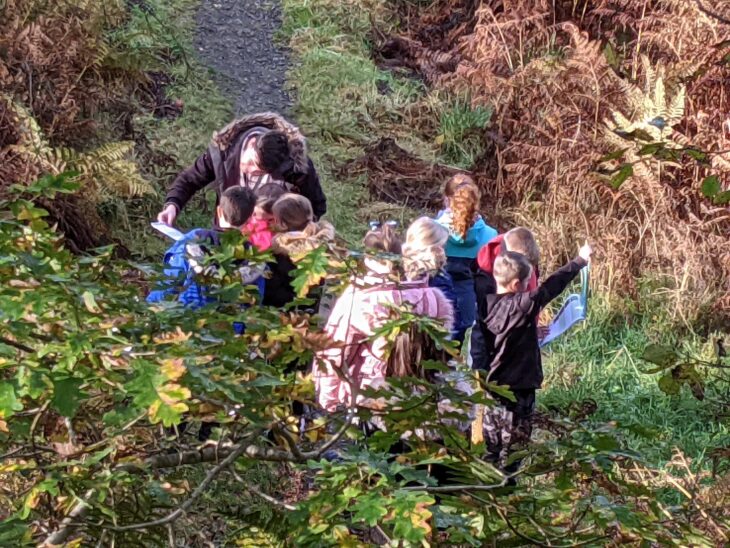A sticky end?
,

It’s not always in the moment that you realise how poignant an occurrence is – in the grand scheme of things. This is exactly what emerged this week when I visited Abronhill Primary to deliver a Creating Natural Connections session to their upper primary school children.
Having been split into 3 groups – the beetle group I recall – had just finished a site survey activity and several of the children were now collecting a variety of seeds (‘pollination evidence’). Once they had identified their finds they could attach them to a small – yet highly effective strip of sticky tape attached to a wrist band made from recycled cardboard.
As I always allow to happen in outdoor learning sessions such as these, the hunt for seeds naturally evolved into a bug hunt. The children gradually became more and more excited at uncovering several species of invertebrates – in and amongst a pile of leaf litter on the school site.
One of these such specimens was a harvestman – easy to spot at this time of year because they are on the move as they go on the look-out for a mate. This particular spindly yet endearing creature presents a wonderful learning opportunity – because all is not as it seems – as so often is the case in the natural world. Even though the humble harvestman has 8 legs and looks at first glance to be a spider – it’s nothing of the kind! Unlike spiders, it has no silk glands – so is unable to spin a web. They are identifiable by observing their round body without a ‘waist’ – meaning that they do not have the distinct 3 body parts to officially be classed as an insect. Neither a spider nor an insect, the harvestman is one of the ‘Opilones’, a group of arachnids closely related to spiders, but also to scorpions – they have prominent jaws. Opilones comes from the Latin word opilio, which means shepherd. This derives from how they resemble European shepherds of old walking on stilts – to get a good view of their flock. But – and this is where it begins to gets poignant – unlike spiders, harvestmen cannot afford to lose any of their acrobatic limbs. Whereas a spider has the remarkable adaptive ability to be able to regenerate their limbs, I explained to the children that our harvestman had no such good fortune.

Having already explained to the children that harvestmen need to use their limbs as a means to trap insects, we talked about how their legs are essentially vital – they are used in place of using a web. (Incidentally, if you look closely you will see that harvestmen have hooks at the end of their legs which they mainly use for catching smaller invertebrates).Understanding all this seemed critical to what happened next – knowledge being a precursor to the drive to care.
And so to return to what had become a rapidly unfolding drama. Where moments before all had been about awe and wonder: observing the delicate stilt walker grace of the harvestman …as it crawled across various children’s hands, suddenly in its place there was tangible panic.
The panic quickly gave way to finger pointing, as it became clear that the harvestman could no longer move. The wee fellow had ventured onto seemingly inescapable territory. A gap on one of the children’s seed bands was revealing just enough of the aforementioned tape to entrap the dear creature’s nimble legs. All looked distinctly hopeless from my perspective and I was loathed to impart false hope. The prognosis for the wee chap did not look good. With my catastrophizing adult mindset, I hadn’t even considered a way out for the creature – wincing to see it had already managed to attach more than half of its limbs to the ultra-effective double sided tape. “Why had I not used something less sticky?” I guiltily thought. How could I have let this happen – especially when I always encourage such very careful handling of such creatures. I could not have felt more disheartened that I had let this happen on my watch.
But, what I hadn’t bargained for is the unwavering will and fearless determination of the children – who had already named the harvestman ‘Frank’. As these two boys immediately leapt to their cause, I humbly watched on to see them work with incredible dexterity and precision to try tried to free the harvestman. Tireless, the boys were clearly not going to give up on this mission – to let Frank die without a good fight was clearly inconceivable.
I was floored by their stoicism. How had I not been able to contemplate another outcome for this pseudo-spider? I had been hopeless in the face of adversity, whereas the children didn’t flinch or doubt their ability to fight the good fight – and win. And I am thrilled to report that win – they did. Frank was freed and could return once more to his home in the leaf litter. I was sure to pass this on to their teacher – it certainly needed some proper acknowledgement. Nearly a week later, when I think back to what I witnessed that afternoon, it is hard not to feel emotional! If I ever needed reminded why I do the work I do, then surely this was all that I ever needed to recall.

It was this almost sticky end that got me thinking this week about how we view the climate emergency and how we overcome the inertia or overwhelm in the face of what seems an unsolvable crisis. In the short shadow of the COP climate change conference on our doorstep, we are being called to face up to what might be our own sticky end. Should leaders fail a 26th time to take action against our current trajectory of burning fossil fuels, we face a depressing climate emergency – on a global scale. The most recent Intergovernmental Panel on Climate Change (IPCC) Report describes how ‘unless there are immediate, rapid and large-scale reductions in greenhouse gas emissions, limiting warming to close to 1.5°C or even 2°C will be beyond reach’. In other words, as we are all beginning to realise, climate change is already happening now – and at an alarming rate. And crucially, if we do not find a way to take immediate action, then the 2 degree ‘danger zone’ is a tipping point that we will not be able to avoid.
And as to how that affects us at a local level – Scottish Peatbog activist Milly Hayward aptly describes it as a ‘nature emergency’- pointing to how biodiversity loss is intrinsically linked to climate change. What that really means is increasingly less nature on our doorstep – the salve of our greenspaces is under a multiple threats from human activity – not just from urbanisation but also from climate change.
In my role to bring outdoor learning into local schools in the Cumbernauld area, I know there is more urgency than ever to share what we have to lose here in our backyard. So I am motivated to find ways to model and encourage conscious caring – as well as awareness of how to protect the nature we are so fortunate to be surrounded by in this part of North Lanarkshire. The Cumbernauld area – being 50% green space – is surprisingly biodiverse and it is increasingly clear that there is a lot here to fight for. We can make sure we are modelling to our children how we can safeguard what we already have here – by creating homes for wildlife in our schools, gardens and communities. It is also worth not forgetting the importance of small acts of kindness – shown towards the nature we encounter everyday in our homes, gardens and on our doorstep.
It is easy to feel powerless when we are faced with our lack of personal ability to control climate change outcomes. But this has yet to hold children back from leading the way in the climate change movement with so much hope and optimism. We have so much to learn from children – especially if we are prepared to finally admit that we haven’t got all the answers.
Maybe this is where we need to acknowledge the need for role reversal – children can already teach us so much where adopting both a learner and growth mindset is concerned. Emerging triumphant from this climate conundrum will require sustained action – and that demands not only unstoppable courage and resilience. It also requires heart. There is a poignancy in seeing how the children were invested in saving the harvestman – which could hold the crucial key to helping us to tackle climate change. Can we take the lead of children – by putting caring at the heart of how we overcome the seeming impossible?
